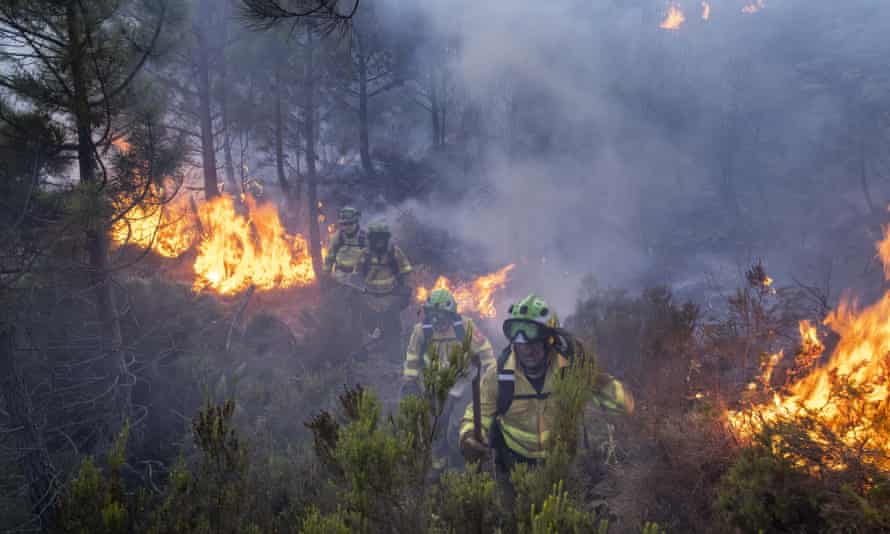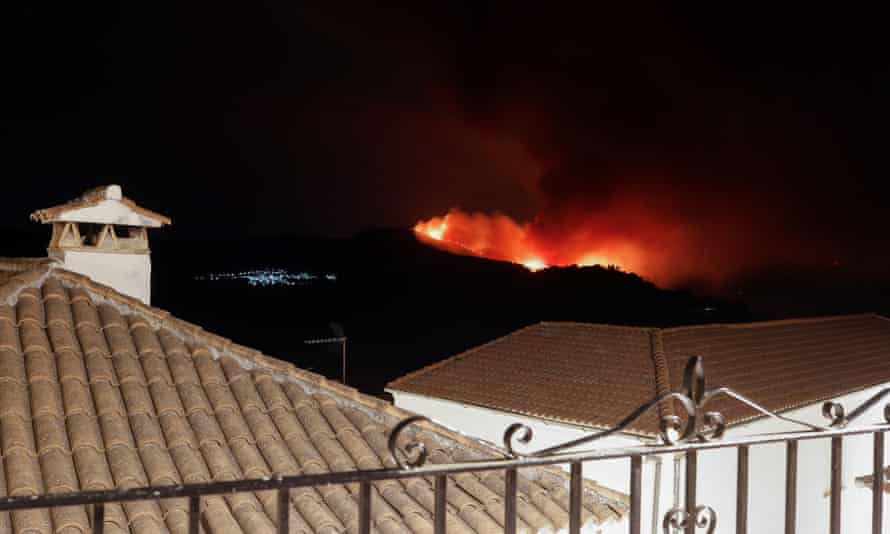Spain wildfire: almost 1,000 emergency workers fighting blaze
Fire in Andalucia region rages for sixth day having already forced evacuation of thousands of people

Almost 1,000 firefighters and emergency workers are battling one of the most intractable Spanish wildfires in recent years as the blaze rages for a sixth day, after devouring at least 7,400 hectares (18,285 acres) of land in the southern region of Andalucia and forcing the evacuation of more than 2,600 people.
On Sunday, 260 members of Spain’s military emergencies unit were deployed to help tackle the fire, which began last Wednesday in the mountainous Sierra Bermeja above the resort town of Estepona, and which now has a perimeter of 53 miles (85km). Experts hope the rain forecast across much of the country on Monday will help extinguish the blaze.
Investigators say they have evidence that the fire, which claimed the life of a 44-year-old firefighter last Thursday, was started deliberately. Announcing the deployment of the military personnel on Sunday night, the prime minister, Pedro Sanchez, said the government and its partners “will work together and tirelessly in the face of the fire that is devastating the province of Malaga”.
The Andalucian regional government’s forest fire service, Infoca, said conditions had improved overnight, adding that efforts were beings focused on the eastern flank of the fire. But it stressed the fire was of a scale and complexity not seen for years, and had been aggravated by neglect of rural areas and the climate crisis.
“Right now, we’re probably dealing with the most complicated fire that Spanish firefighting services have faced in recent years,” said Juan Sanchez, the director of Infoca’s regional operations centre.
“We’ve spent a lot of time talking about how difficult the abandonment of rural areas and climate change are making things. But now we’re living through it for ourselves. I would ask everyone to wait until we’ve put out the fire and to avoid counting on easy solutions – like fires putting themselves out in winter. Because this is a complex problem with complex solutions.”

Most of those evacuated from parts of Estepona had been able to return home by Monday, but 1,700 people from six towns and villages evacuated on Sunday – Genalguacil, Jubrique, Farajan, Pujerra, Alpandeire and Juzcar – were being hosted elsewhere.
Hot and dry temperatures combined with strong winds have created a perfect storm, turning the blaze into a “hungry monster”, according to Alejandro Garcia, Infoca’s deputy operational chief. “The potency and strength of this wildfire is unusual for the kind of blazes that we are used to seeing in this country,” he told reporters on Sunday.
The firefighting agency released aerial pictures showing towering plumes of smoke emerging from rugged terrain, which it said made it hard for crews to access some areas on the ground. More than 40 aircraft are helping to fight the blaze from above.
Wildfires are common in southern Europe during the hot, dry summer months, but they have been particularly prevalent around the Mediterranean Sea this year, worsened by the intense August heatwaves.
In Spain, more than 75,000 hectares (186,000 acres) of forest and bush areas have burned in the first eight months of the year, according to the Ministry for the Ecological Transition and the Demographic Challenge.
Climate scientists say there is little doubt the burning of coal, oil and natural gas is driving more extreme climate events, such as heatwaves, droughts, wildfires, floods and storms.
Associated Press contributed to this report